生态友好型植物萃取法制备银纳米颗粒及其湿度传感性能
IF 4.9
Q1 CHEMISTRY, ANALYTICAL
引用次数: 0
摘要
本文首次采用植物提取银纳米粒子(Ag NPs)制备了一种电阻式薄膜湿度传感器。最初,Ag NPs是通过一种可持续的方法合成的,使用姜黄粉的水提取物,其中植物生物材料既可以作为还原剂也可以作为封盖剂。采用x射线衍射(XRD)、x射线光电子能谱(XPS)、傅里叶变换红外光谱(FT-IR)、紫外可见光谱(uv -可见光)、高分辨率扫描电镜(HR-SEM)和能量色散x射线能谱(EDX)技术对Ag NPs的结构、形态和组成性质进行了表征。XRD结果表明,在(111)、(200)、(220)、(311)平面的38.62°、44.16°、66.29°、76.53°处出现了明显的衍射峰,证实了银纳米粒子的立方相结构。经HR-SEM分析证实其为球形。紫外可见光谱在429 nm处显示出银纳米粒子的特征峰。在5% ~ 98%的相对湿度(RH)和3种不同的测试频率(100hz、500 Hz和1000hz)下,测试了银纳米粒子的湿度传感性能。实验结果表明,最佳测试频率为500hz。因此,我们观察到快速响应(28秒)和恢复(47秒),低迟滞特性和长期稳定性(长达30天)。由于这一优点,所实现的传感器在智能食品包装、呼吸分析、非接触传感和土壤监测方面具有很大的应用前景。本文章由计算机程序翻译,如有差异,请以英文原文为准。
Silver nanoparticles prepared via an eco-friendly phytoextract method and their humidity sensing properties
In this work, a resistive-type thin film humidity sensor is developed using phytoextracted silver nanoparticles (Ag NPs) for first time. Initially, Ag NPs were synthesized by a sustainable approach using the aqueous extract of turmeric powder, in which plant biomaterials function as both reducing as well as capping agents. The Ag NPs structural, morphological and composition properties were characterized using X-ray diffraction (XRD), X-ray photoelectron spectrum (XPS), Fourier transform infrared spectrum (FT-IR), UV–Visible, High resolution scanning electron microscopy (HR-SEM) coupled with energy dispersive X-ray (EDX) spectrometer techniques. The XRD result revealed a significant diffraction peak appeared at 38.62°, 44.16°, 66.29°, 76.53° which correspondent to the (111), (200), (220) and (311) plane would confirm the crystalline nature with cubic phase structure of Ag NPs. The spherical shaped morphological nature has been confirmed by HR-SEM analysis. The UV–Visible spectra showing a characteristic peak of Ag NPs at an absorption maximum at 429 nm. The humidity sensing properties of Ag NPs have been exposed to a humidity range from 5 % to 98 % relative humidity (RH) and three different testing frequency (100, 500 and 1000 Hz). The obtained results confirmed that the optimum testing frequency is 500 Hz. Consequently, we observed fast response (28 s) and recovery (47 s), low hysteresis characteristic, and long-term stability (up to 30 days). Owing to this merit, the implemented sensor has been illustrated for a great application prospect in smart food packaging, breath analysis, non-contact sensing, and soil monitoring.
求助全文
通过发布文献求助,成功后即可免费获取论文全文。
去求助
来源期刊

Sensing and Bio-Sensing Research
Engineering-Electrical and Electronic Engineering
CiteScore
10.70
自引率
3.80%
发文量
68
审稿时长
87 days
期刊介绍:
Sensing and Bio-Sensing Research is an open access journal dedicated to the research, design, development, and application of bio-sensing and sensing technologies. The editors will accept research papers, reviews, field trials, and validation studies that are of significant relevance. These submissions should describe new concepts, enhance understanding of the field, or offer insights into the practical application, manufacturing, and commercialization of bio-sensing and sensing technologies.
The journal covers a wide range of topics, including sensing principles and mechanisms, new materials development for transducers and recognition components, fabrication technology, and various types of sensors such as optical, electrochemical, mass-sensitive, gas, biosensors, and more. It also includes environmental, process control, and biomedical applications, signal processing, chemometrics, optoelectronic, mechanical, thermal, and magnetic sensors, as well as interface electronics. Additionally, it covers sensor systems and applications, µTAS (Micro Total Analysis Systems), development of solid-state devices for transducing physical signals, and analytical devices incorporating biological materials.
 求助内容:
求助内容: 应助结果提醒方式:
应助结果提醒方式:


